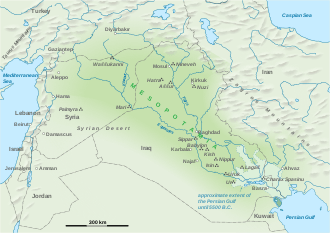Washukanni
Washukanni (also spelled Waššukanni or Vasukhani) was the capital of the Hurrian kingdom of Mitanni, from around 1500 BCE to the 13th century BCE. Its precise location is unknown. A proposal locates it under the largely unexcavated mound of Tell el Fakhariya, near Tell Halaf in Syria, but this idea was rejected by Edward Lipinski,[1] however this identification received a new support by Stefano de Martino, Mirko Novák and Dominik Bonatz due to recent archaeological excavations by a German team.[2] Its etymology in Sanskrit, which was used by the Mitanni, is "Vasukhani", वसुखनी, the "mine of wealth" as the Vasu are the gods who are wealth-givers.[3]
The city is known to have been sacked by the Hittites under Suppiluliuma I (reigned c. 1344–1322 BCE) in the first years of his reign, whose treaty inscription[4] relates that he installed a Hurrian vassal king, Shattiwaza. The city was sacked again by the Assyrian king Adad-nirari I around 1290 BCE, but very little else is known of its history.
See also
References
- Lipiński, Edward (2000). The Aramaeans: Their Ancient History, Culture, Religion. Peeters Publishers. p. 120. ISBN 978-90-429-0859-8.
- De Martino, Stefano, 2018. "Political and Cultural Relations between the Kingdom of Mittani and its Subordinated Polities in Syria and Southeast Anatolia", in Changing Faces of Kingship in Syria-Palestine 1500-500 BCE, Ugarit Verlag, p. 38: "...the recent German archaeological excavations at Tell Fekheriye support the assumption that the capital of Mittani, Wassukkanni, was located there..." See also Novák (2013: 346) and Bonatz (2014).
- S. Kak, Akhenaten, Surya and the Rgveda, in "The Golden Chain", Govind Chandra Pande (editor), CRC, 2005.
- Suppiluliuma-Shattiwaza treaty excerpts. GeoCities, archived at webcitation.org and archive.org
